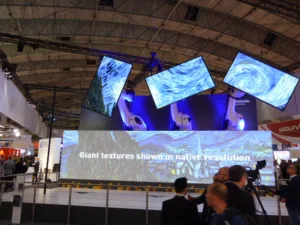Michael Pullan is PSCEU’s European PR manager, and walked the stand with us as we viewed the company’s newest developments. Light ID was first on the list.
Light ID is similar to Li-Fi, in that it transfers data using light. However, the Panasonic representative that we spoke to said that Li-Fi is used to send large amounts of data, like WiFi. Light ID is more like a QR code, pointing a user’s device to a certain website or similar.
The range of the technology – the distance at which a device’s camera can detect the information coming from the backlight – is 8m. The backlight blinks at between 1,000 and 20,000Hz, and so the flicker is said to be undetectable to the human eye. Testing with some demonstration iPhones, the detection was extremely quick: there wasn’t even time to finish pointing the camera at the screen. The representative said that detection time was 0.3 seconds.
Tests were done in Inza, a large shopping centre in Japan, using a light box. Shoppers could point their devices at the box and get links to coupons and discount codes. It will also be used at the Tokyo Big Sight exhibition centre, and Panasonic is in talks with a Japanese airport, as well.
Panasonic’s AF1 series was being demonstrated. The SoC inside is based on Android and is capable of running HTML5. Users will have a choice of 12 different types of signage software, including NetDisplay, Scala and SmartSign.
Last year, the big draw at Panasonic’s stand was its projection mapping on to a Tesla car. This year, the company had more room to play with as it has moved into Samsung’s vacated spot in Hall 1: the largest at the show. The demonstration involved robotics: three LFDs on robotic arms were moving around in front of a projection screen. Their movements were synchronised with the content, so that they appeared to be controlling movements of on-screen characters and graphics.

